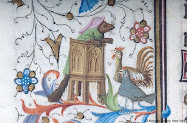Relics, after all, were big business for popular pilgrimage spots, bringing in the punters to make their donations to the shrine itself and then spend up large on tourist trinkets like pilgrimage badges. Competition amongst the various shrines was fierce, and late medieval texts by both religious writers and laymen refer to avaricious monks making forgeries and condemn or mock the proliferation of sham shrines and relics (though most didn’t disavow that miracles that could be produced by the genuine article).
The lengths to which some people were prepared to go to secure a relic could be pretty extreme. One of my favourite stories is that of Hugh, Bishop of Lincoln (later St. Hugh). On a pilgrimage to the abbey of Fécamp in Normandy, he asked for a piece of the arm bone of St. Mary Magdalene – the abbey’s most precious relic – to take back to England with him. His request denied by the monks (you can imagine the haggling: ‘The index finger? No? How about the pinkie? Come on, chaps, I’d settle for the tip’), our quick-witted bishop seizes on the relic and takes a bite – a chunk! – out of the poor lady’s arm. I can just picture the undignified scuffle that must then have ensued, with the monks trying to wrestle the bit of bone out of Hugh’s mouth and the bishop, jaws tightly clamped, fiercely resisting them. (Hugh later tasted a bit of his own medicine when his head was stolen from its shrine in 1364.)
 I had my own close encounter with a saintly skeleton at the Benedictine abbey of Saint-Pierre d'Hautvillers, which is nestled in a hilltop village overlooking some of the best vineyards of Champagne. Here, boxed up in this somewhat neglected-looking reliquary on one side of the abbey church, are the bones of St. Nivard, Archbishop of Reims (655 – 669) and brother-in-law of the Frankish king Childeric II. He was the founder of the abbey, but we bubbly-quaffing pilgrims now know it much better as the final resting place of friar Dom Pérignon.
I had my own close encounter with a saintly skeleton at the Benedictine abbey of Saint-Pierre d'Hautvillers, which is nestled in a hilltop village overlooking some of the best vineyards of Champagne. Here, boxed up in this somewhat neglected-looking reliquary on one side of the abbey church, are the bones of St. Nivard, Archbishop of Reims (655 – 669) and brother-in-law of the Frankish king Childeric II. He was the founder of the abbey, but we bubbly-quaffing pilgrims now know it much better as the final resting place of friar Dom Pérignon.



5 comments:
What have we got here...?
A cannibalistic man of the cloth; God! that bit of relic must've tasted foul.
His head was no longer of gastronmic interest by the time the Bish was no longer in it.
Dom Perignon - whatever takes your fancy, I suppose, but not for quaffing with decomposed offerings, I trust.
As for the Turin Shroud; it has become a non-event. I wonder why there is a new attempt at stirring up interest. Tourism perhaps. Have to try harder methinks.
It's kind of ghoulish to think that a form of ritual cannibalism is central to Catholic practice. You could be right on the tourism angle for the shroud. I just read recently that it's going on public display in 2010, so all this controversy is no doubt a good way to drum up some business.
If you think about it, ritual cannibalism is part of Christian worship. The Blood of Christ, the body of Christ....
Great post! Was it you who posted the Blackadder Relic bit? This post reminded me of it! Are there folks your way who make small fortunes when assorted Religious Figures appear in their waffles, etc? As for the 2010 showing of the Shroud... I agree with your suspicion about drumming up interest. Between social media, the media's need to be fed, fascination with the Shroud regardless of origins, etc., I expect to see a huge uptick in media madness. Wonder how much of it will mention the upcoming exhibit, and how much of it will be the wizard behind the curtain? Hmmm... public history paper, anyone? ;)
The relic scene in Blackadder is a classic. Until I started studying this stuff, I didn't realise how close to the truth it was! We do get the odd appearance of the Virgin Mary in a burnt bit of toast or something. From memory, there was a case last year. I don't know if anyone really took it seriously, but someone still paid a few hundred bucks for the toast.
It will be interesting to see how the Shroud exhibit will deal with all the controversy about its authenticity - if it will just skate over it, or debunk the debunkers, or present both sides fairly and leave the public to reach their own conclusions (though generally, museums are a bit too conservative to do the latter).
Post a Comment